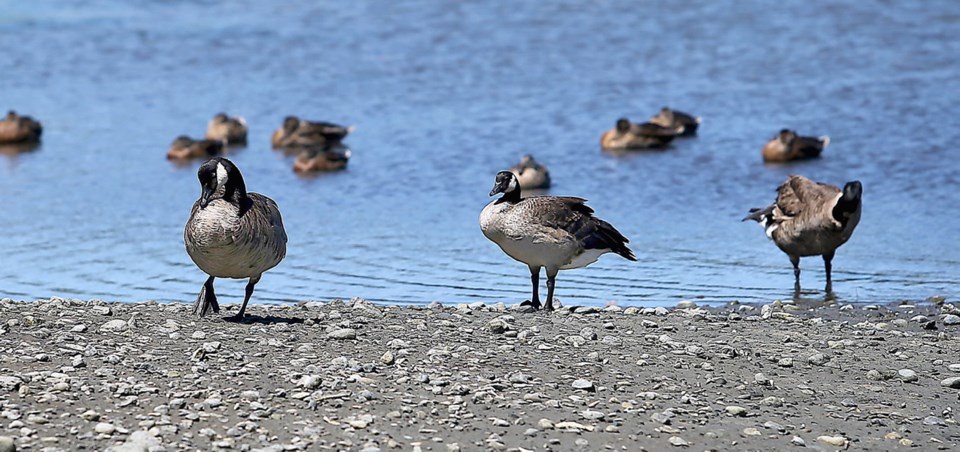Rob Galey is no fan of Canada geese.
The Saanich farmer has watched over the years as increasing numbers of the birds descend on his crops in spring and fall, gobbling up plants and eating through profits.
They come in such large flocks that they can destroy an acre of corn in a morning, he said.
“Our lightest years would be losses over $10,000.”
And that doesn’t include the time and money spent covering crops in the spring and fall, or stringing lines across fields to deter geese from landing.
“It’s a constant battle and the whole problem that started up in the last few years is geese are now night foraging when we’re not here,” Galey said.
“We will come in the middle of the night to chase them out, but you’re waking up the whole neighbourhood when you send thousands of geese over people’s houses at three in the morning.”
Galey Farms isn’t alone, either. A growing population of non-migratory Canada geese in the capital region is destroying crops across the Saanich Peninsula, damaging critical salmon habitat and fouling beaches and playing fields.
It’s got so bad that Greater Victoria politicians say they can no longer wait for federal or provincial help to deal with the issue.
Colin Plant, who chairs the Capital Regional District board, wrote to the federal government last year asking for more money to tackle the problem, but never received a response.
So now he’s calling for the district to investigate the feasibility of setting up its own region-wide geese-management service.
“I’m willing for the CRD to step forward and say: ‘We, in the absence of leadership from other levels of government, will show leadership for our environment and our farmers,’ ” he told the district’s regional parks committee this past week.
Committee members unanimously supported Plant’s recommendation that the main CRD board ask staff to prepare a report on the issue. “Personally, I’m in favour of a service, but I think we need to find out what it would cost, what it would look like, who would be involved and what are the parameters,” he said.
View Royal Mayor David Screech backed Plant’s motion, saying a co-ordinated regional approach to the problem makes the most sense.
“When you look 10 years down the road, if we continue in a disjointed way, the results are going to be even worse,” he said.
Garreth Ashley of the non-profit Guardians of Mid-Island Estuaries Society said helicopter surveys estimate the capital region’s geese population at 3,500 to 4,500 — and growing.
The geese were introduced to Vancouver Island in the late 1960s and early 1970s to increase hunting and wildlife-viewing opportunities. But as urban areas grew and hunting declined, the population expanded.
Ashley, a wildlife biologist, said many of the geese arrived as goslings and never learned to migrate. “Also, our beautiful weather has made it so that … migration is not particularly needed by the species.”
He recommended that the CRD establish an annual egg-addling program, run by professional biologists, who will locate the birds’ nests in the spring and shake their eggs to halt embryonic development.
Ashley said the society typically operates an addling crew of four people during the nesting season from late March to early May. “It’s not a very large crew needed, but for an addling program in this region, you’re looking at somewhere between $25,000 to $30,000 a year.”
Any program, however, would need to remain in place for the long haul. “With addling, you’re never going to get a quick population decline, as Canada geese live into their mid-20s,” he said.
“You’re looking at least the next 10 years of a committed addling program to really see the decline.”
Ashley said the society initially began tackling the problem because of the damage to estuaries, where geese graze on a type of sedge grass that provides important cover for salmon.
But geese also cause “hundreds of thousands of dollars” damage to farm crops every year, he said.
“It’s a massive burden on our local agricultural community.”
As for the damage to beaches and playing fields, the problem is so bad in some places that Juan de Fuca Electoral Area director Mike Hicks was dubbed a “Poop Hero” this year for purchasing a machine that cleans goose droppings off soccer pitches.
CRD directors acknowledge ongoing concerns about other wildlife, including deer and grey squirrels. But the parks committee decided it was important to tackle one problem at a time.
“I agree that we need to keep it focused on the geese and do a really good job on the geese,” Saanich Mayor Fred Haynes said. “Otherwise, we run into scope creep and we’ll end up addling ourselves in our own ambitions.”
Victoria Coun. Ben Isitt, who chairs the parks committee, advocated a “non-lethal” approach, arguing that the district is more likely to win public support for a program that doesn’t involve killing geese.
But Metchosin Mayor John Ranns questioned the effectiveness of such a strategy.
“As for the non-lethality, I don’t know, that’s a bit of a pipe dream, too” he said. “Oftentimes, the only time you can deal with it is to knock ’em off.”



